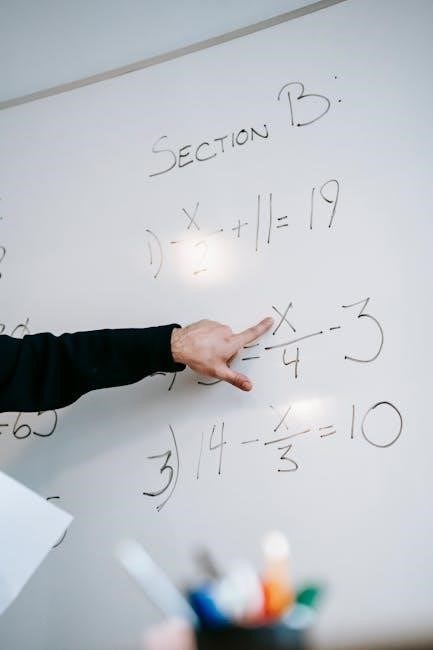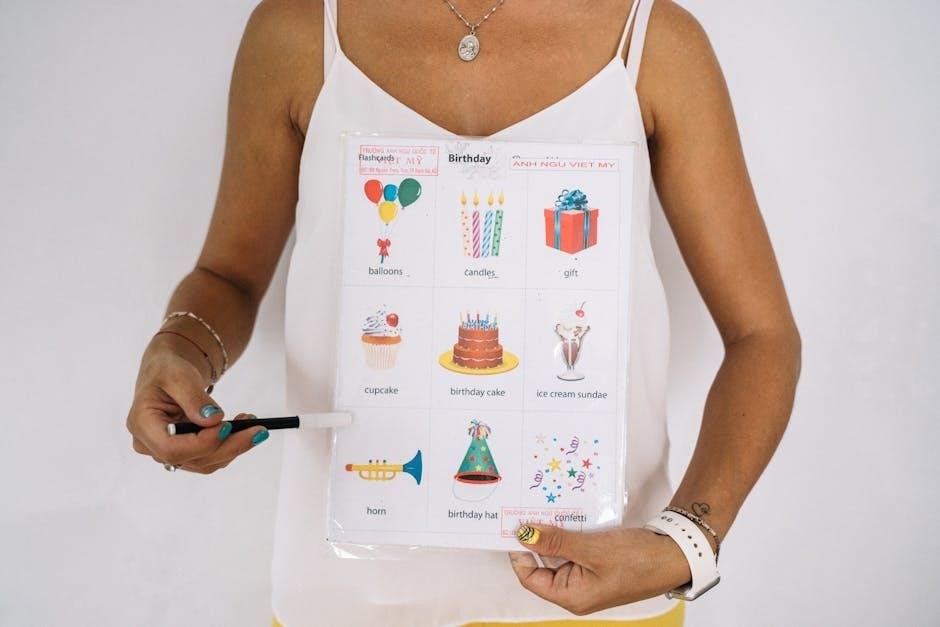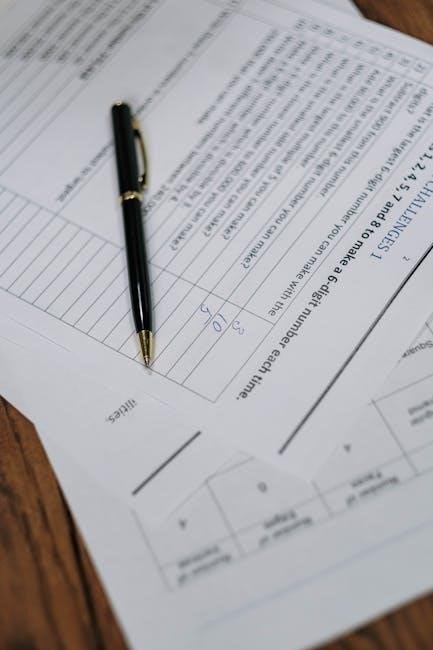
Understanding Decomposing Fractions
Decomposing fractions involves breaking down complex fractions into simpler unit fractions or mixed numbers․ This skill helps 4th graders understand fraction relationships and improves math problem-solving abilities․ Using visual tools like tape diagrams or fraction circles makes the process engaging and accessible for young learners․ Worksheets, such as the 4th grade PDF resources, provide structured practice in breaking down improper fractions into manageable parts, ensuring a strong foundation in fraction decomposition․
1․1․ Definition and Basics of Decomposing Fractions
Decomposing fractions is a mathematical process where a single fraction is broken down into two or more simpler fractions, often unit fractions․ This method helps students understand the relationship between different parts of a whole․ For 4th graders, decomposing fractions typically involves breaking improper fractions into unit fractions or mixed numbers․ The process begins with identifying the numerator and denominator, then expressing the fraction as a sum of simpler fractions․ Unit fractions, which have a numerator of 1, are fundamental to this process․ For example, the fraction 3/4 can be decomposed into 1/4 + 1/4 + 1/4․ Visual models like tape diagrams and fraction circles are often used to provide a concrete representation of the decomposition process․ Understanding the basics of decomposing fractions is essential for building a strong foundation in fraction operations and problem-solving․
1․2․ Importance of Decomposing Fractions in Math Education
Decomposing fractions is a fundamental skill in math education, especially for 4th graders, as it enhances their understanding of fraction relationships․ This process helps students grasp how fractions can be broken down into simpler parts, making complex concepts more manageable․ By mastering decomposition, students improve their ability to add, subtract, and compare fractions․ It also fosters problem-solving skills and prepares them for advanced math topics like algebra․ Worksheets, such as the 4th grade PDF resources, provide hands-on practice, reinforcing these skills․ Decomposing fractions encourages critical thinking and visualization of mathematical concepts, which are essential for academic success․ This foundational skill not only strengthens math fluency but also builds confidence in tackling more challenging problems in the future․
1․3․ Real-World Applications of Fraction Decomposition
Fraction decomposition has practical uses in everyday life, making it a valuable skill for students to master․ For instance, cooking and baking often require adjusting recipe measurements, where understanding how to break down fractions is essential․ If a recipe calls for 3/4 cups of sugar and you only have a 1/4 cup measure, knowing how to decompose 3/4 into three 1/4 parts simplifies the task․ Similarly, in construction or woodworking, precise measurements are critical, and decomposing fractions ensures accuracy․ Financial calculations, such as splitting bills or understanding discounts, also benefit from this skill․ Worksheets like the 4th grade PDF resources help students connect these abstract concepts to tangible scenarios, making learning both relevant and engaging․ By mastering fraction decomposition, students develop a tool that will aid them in various real-world situations․

Visual Models for Decomposing Fractions
Visual models, such as tape diagrams, fraction circles, and number lines, provide concrete representations of fraction decomposition․ These tools help students visualize and simplify the process, making it more accessible for 4th graders․
2․1․ Using Tape Diagrams to Decompose Fractions
Tape diagrams are a powerful visual tool for decomposing fractions, especially for 4th graders․ These diagrams represent fractions as divided segments, where each part can be easily identified and manipulated․ By breaking down a fraction into equal parts, students can visualize how unit fractions combine to form the original fraction․ For example, a tape diagram of 3/4 might show three equal sections, each labeled 1/4, demonstrating how they add up to the whole․ This method is particularly effective for improper fractions and mixed numbers, as it provides a concrete representation of abstract concepts․ Worksheets often include tape diagrams to guide students in practicing decomposition, helping them develop a deeper understanding of fraction relationships and operations․ This hands-on approach makes learning engaging and accessible, especially for visual learners․
2․2․ Fraction Circles as a Tool for Decomposition
Fraction circles are a widely used tool in teaching fraction decomposition to 4th graders․ These circular diagrams are divided into equal parts, each representing a unit fraction․ By shading or highlighting sections, students can visually break down complex fractions into simpler parts․ For instance, a circle divided into eighths can help decompose 5/8 into 1/8 + 1/8 + 1/8 + 1/8 + 1/8․ This method is especially effective for understanding how multiple unit fractions combine to form a larger fraction․ Worksheets often incorporate fraction circles to provide hands-on practice, allowing students to explore and verify their decompositions․ The tactile and visual nature of fraction circles makes them an engaging and effective aid in mastering fraction decomposition skills, particularly for kinesthetic and visual learners․
2․3․ Number Lines in Fraction Decomposition
Number lines are a valuable tool for teaching fraction decomposition to 4th graders; By marking a number line with equal parts, students can visually represent fractions and break them into smaller unit fractions․ For example, a number line from 0 to 1 can be divided into eighths, allowing students to see how 5/8 can be decomposed into five segments of 1/8․ This method helps students understand the relationship between parts and wholes․ Worksheets often include number lines for practice, enabling students to mark and label fractions․ The visual and sequential nature of number lines makes them particularly effective for understanding how fractions can be broken down and reassembled․ This approach supports kinesthetic and visual learners, providing a concrete way to explore fraction decomposition and verify results․

Step-by-Step Guide to Decomposing Fractions
A step-by-step guide helps 4th graders break down improper fractions into unit fractions or mixed numbers․ Start by identifying the whole number part, then decompose the remainder using visual models like tape diagrams or fraction circles․ This structured approach ensures clarity and understanding, making fraction decomposition manageable and engaging for young learners․
3․1․ Breaking Down Improper Fractions into Unit Fractions
Breaking down improper fractions into unit fractions is a fundamental skill for 4th graders learning to decompose fractions․ This process involves expressing an improper fraction, which has a numerator greater than the denominator, as a sum of simpler unit fractions․ For example, the improper fraction 7/4 can be decomposed into 1/4 + 1/4 + 1/4 + 1/4 + 1/4 + 1/4 + 1/4, or more simply, 1 3/4 as a mixed number․ Worksheets specifically designed for 4th graders often include exercises that guide students through this decomposition process using visual models like tape diagrams or fraction circles․ These tools help students visualize how improper fractions can be divided into equal parts, making the concept more tangible and easier to grasp․ Regular practice with these exercises builds confidence and fluency in handling fraction operations․
3․2․ Converting Mixed Numbers into Unit Fractions
Converting mixed numbers into unit fractions is an essential step in mastering fraction decomposition․ A mixed number, such as 1 1/2, can be decomposed into a whole number and a fraction, which is then expressed as a sum of unit fractions․ For example, 1 1/2 can be broken down into 1/2 + 1/2․ This process helps students understand how mixed numbers can be represented as multiple parts of a whole․ Worksheets designed for 4th graders often include exercises that guide students in identifying and writing the unit fractions that make up a mixed number․ Visual models, such as tape diagrams or fraction circles, are invaluable in illustrating this concept․ By practicing these conversions, students gain a deeper understanding of fraction relationships and improve their ability to solve complex math problems involving mixed numbers and unit fractions․

3․3․ Verifying Results Through Simplification
Verifying results through simplification is a crucial step in ensuring the accuracy of fraction decomposition․ After breaking down a fraction into unit fractions, students should simplify the sum to confirm it equals the original fraction․ For example, if 3/4 is decomposed into 1/4 + 1/4 + 1/4, adding these unit fractions together should result in 3/4․ This verification process reinforces the understanding of fraction equivalence and builds confidence in problem-solving skills․ Worksheets often include exercises where students add unit fractions and reduce improper fractions to their simplest form․ Simplification also helps identify any errors in the decomposition process, ensuring that the results are correct․ By consistently practicing verification, students develop a stronger grasp of fraction operations and their applications in real-world scenarios․

Worksheets for Practicing Decomposing Fractions
Worksheets provide structured exercises for students to practice decomposing fractions into unit fractions or mixed numbers․ These resources, often available as 4th-grade PDFs, include visual models and targeted activities to enhance understanding and retention of fraction decomposition skills․
4․1․ Features of Effective 4th Grade Worksheets
Effective 4th grade worksheets for decomposing fractions should include clear instructions, visual aids like tape diagrams or fraction circles, and step-by-step exercises․ They should cater to different learning styles, offering both visual and hands-on activities․ Interactive elements, such as fill-in-the-blank questions or matching games, keep students engaged․ Worksheets should also provide a variety of exercises, from breaking down improper fractions to creating mixed numbers․ Including word problems helps apply fraction decomposition to real-world scenarios․ Answer keys are essential for self-assessment and teacher feedback․ The content should align with curriculum standards, ensuring comprehensive coverage of fraction decomposition skills․ Worksheets should be printable in PDF format for easy accessibility, making them a valuable resource for both classroom and home use․ These features collectively create a structured and engaging learning experience for young students mastering fraction decomposition․

4․2․ Printable PDF Worksheets for 4th Graders
Printable PDF worksheets are a convenient and effective tool for teaching 4th graders how to decompose fractions․ These worksheets are designed to be easily downloaded and printed, making them accessible for both classroom use and homework․ They often include a variety of exercises, such as breaking down improper fractions into unit fractions and converting mixed numbers․ Many PDF worksheets feature visual aids like tape diagrams and fraction circles to help students visualize the decomposition process․ Some worksheets also incorporate interactive elements, such as fill-in-the-blank questions and matching games, to keep students engaged․ Additionally, they often include answer keys, allowing students to check their work and receive immediate feedback․ The structured format of these PDF worksheets ensures that students can practice and master fraction decomposition at their own pace․ This makes them a valuable resource for teachers and parents alike․
4․3․ Interactive and Engaging Worksheet Activities
Interactive and engaging worksheet activities are essential for keeping 4th graders motivated while learning to decompose fractions․ These activities often include fill-in-the-blank exercises, matching games, and hands-on tasks that involve visual aids like tape diagrams or fraction circles․ Some worksheets incorporate real-world scenarios, such as dividing pizzas or cakes, to make the concept relatable․ Interactive elements like dragging and dropping fraction pieces or solving puzzles online can also enhance the learning experience․ These activities cater to different learning styles, ensuring that every student can grasp the concept of fraction decomposition in a fun and dynamic way․ By combining practice with creativity, these worksheets make learning fractions an enjoyable and effective process for young students․

Teaching Strategies for Decomposing Fractions
Effective strategies include using visual models like tape diagrams and fraction circles to simplify complex fractions․ Incorporating real-world examples, such as dividing food, makes learning relatable and engaging for 4th graders․
5․1․ Using Visual Aids in the Classroom
Visual aids are essential for teaching fraction decomposition to 4th graders, as they provide a concrete representation of abstract concepts․ Tools like tape diagrams, fraction circles, and number lines help students visualize how fractions can be broken down into unit fractions or mixed numbers․ These models allow for hands-on learning, making the decomposition process more intuitive and engaging․ For example, tape diagrams can be divided into equal parts to illustrate the sum of unit fractions, while fraction circles can be shaded to demonstrate specific portions․ Incorporating these aids into classroom activities ensures that students can see and interact with the math, fostering a deeper understanding․ Additionally, visual aids can be paired with worksheets, such as the 4th grade PDF resources, to reinforce learning and provide structured practice․ This combination of visual and hands-on methods supports diverse learning styles and enhances retention;
5․2․ Incorporating Real-World Scenarios
Integrating real-world scenarios into fraction decomposition lessons helps 4th graders connect abstract math concepts to everyday life․ For instance, students can practice decomposing fractions while solving problems involving cooking, measuring ingredients, or dividing objects like toys or candy․ These practical examples make learning relatable and engaging․ Teachers can use worksheets, such as the 4th grade PDF resources, to create activities that mimic real-life situations, such as adjusting recipes or sharing materials equally․ By applying fraction decomposition to tangible scenarios, students develop problem-solving skills and understand the relevance of math in their lives․ This approach not only enhances understanding but also builds confidence in using fractions to solve real-world challenges․ Making math meaningful through such contexts ensures that students grasp the importance of decomposing fractions beyond the classroom;
5․3․ Encouraging Peer-to-Peer Learning
Peer-to-peer learning is a powerful strategy to reinforce fraction decomposition skills among 4th graders․ By working in pairs or small groups, students can collaborate on worksheets, such as the 4th grade PDF resources, to solve problems together․ This approach fosters a supportive learning environment where students can share ideas and strategies․ Teachers can encourage group work, allowing students to explain their reasoning and learn from one another․ Interactive activities, such as comparing solutions or discussing different methods, can deepen understanding․ Additionally, peer teaching enables students to solidify their own knowledge while helping others․ This collaborative approach not only builds confidence but also enhances communication and teamwork skills․ By integrating peer-to-peer learning, educators create a dynamic classroom where students actively engage with and master fraction decomposition concepts․

Common Challenges and Solutions
Students often struggle with understanding unit fractions and breaking them down․ Visual aids like tape diagrams and fraction circles help simplify the process, making decomposition more intuitive and accessible for young learners․
6․1․ Difficulties in Understanding Unit Fractions
Many 4th graders struggle with understanding unit fractions, which are essential for decomposing larger fractions․ Common challenges include grasping the concept of a fraction as a single whole part, transferring this understanding to improper fractions, and visualizing how unit fractions combine to form mixed numbers․ Students often find it difficult to see how multiple unit fractions can add up to a whole or a mixed number, leading to confusion and errors․ Additionally, without proper visual aids, such as fraction circles or tape diagrams, abstract thinking about fraction parts can be overwhelming․ To address these difficulties, teachers often recommend breaking down fractions into smaller, more manageable parts and using real-world examples to illustrate decomposition․ Worksheets and interactive activities, like those in 4th grade PDF resources, provide structured practice to build confidence and fluency in handling unit fractions․
6․2․ Strategies to Overcome Fraction Decomposition Hurdles
Overcoming challenges in fraction decomposition requires targeted strategies․ Visual aids like tape diagrams and fraction circles help students visualize how unit fractions combine․ Breaking problems into smaller steps ensures gradual understanding․ Encourage real-world connections, such as dividing food or objects, to make concepts relatable․ Interactive activities, like peer-to-peer learning, foster collaboration and engagement․ Immediate feedback through worksheets or digital tools helps identify errors early․ Celebrating small successes builds confidence and motivation․ Incorporating games and hands-on exercises makes learning fun and less intimidating․ Providing structured practice, such as through 4th grade PDF worksheets, reinforces skills and promotes mastery․ By combining these approaches, educators can address individual learning needs and help students overcome decomposition hurdles effectively․
6․3․ Case Studies of Successful Learning Outcomes
Case studies highlight the effectiveness of strategies in overcoming fraction decomposition challenges․ In one classroom, 4th graders using the Reveal Math series showed significant improvement after practicing with targeted worksheets․ Visual tools like tape diagrams and fraction circles enhanced understanding, while peer-to-peer learning fostered collaboration․ Incorporating real-world scenarios, such as dividing pizzas or candy, made concepts relatable and engaging․ Interactive activities, including games and hands-on exercises, kept students motivated․ Teachers reported improved test scores and increased confidence in solving fraction problems․ Parents noted better problem-solving skills at home․ These successes demonstrate how structured practice, combined with creative teaching methods, can lead to mastery of fraction decomposition․ By sharing these outcomes, educators can replicate effective strategies in their own classrooms, ensuring similar achievements for their students․

Advanced Techniques for Fraction Decomposition
Advanced methods include breaking fractions into multiple unit fractions or mixed numbers, utilizing algebraic approaches, and exploring varied decomposition strategies to enhance problem-solving skills and deepen mathematical understanding․
7․1․ Decomposing Fractions into More Than Two Unit Fractions
Decomposing fractions into more than two unit fractions is an advanced skill that builds on basic fraction decomposition․ This method involves breaking down a single fraction into three or more simpler unit fractions, enhancing problem-solving abilities․ For example, the fraction ( rac{5}{6} ) can be decomposed into ( rac{1}{6} + rac{1}{6} + rac{3}{6} )․ Visual models like tape diagrams or fraction circles are effective tools for this process, as they provide a concrete representation of how fractions can be divided into multiple parts․ Worksheets designed for 4th graders often include exercises that challenge students to explore various combinations of unit fractions․ This advanced technique not only deepens the understanding of fraction relationships but also prepares students for more complex math operations in the future․ Regular practice with these exercises helps build confidence and fluency in handling fractions․
7․2․ Using Algebraic Methods for Decomposition
Using algebraic methods for decomposing fractions introduces students to a more analytical approach․ This technique involves setting up equations to represent the decomposition process․ For example, to decompose ( rac{7}{8} ), students can express it as ( rac{a}{8} + rac{b}{8} + rac{c}{8} ), where ( a + b + c = 7 )․ By solving these equations, students develop problem-solving skills and a deeper understanding of fraction relationships․ Worksheets often include exercises where students use algebraic expressions to break down fractions into multiple unit fractions․ This method enhances mathematical reasoning and prepares students for advanced concepts․ Regular practice with these algebraic techniques helps build confidence and fluency in handling complex fraction problems, making it a valuable tool for math education․
7․3․ Exploring Multiple Ways to Decompose a Fraction
Exploring multiple ways to decompose a fraction fosters creativity and critical thinking in students․ For instance, the fraction ( rac{7}{8} ) can be broken down into ( rac{1}{8} + rac{2}{8} + rac{4}{8} ) or ( rac{3}{8} + rac{4}{8} )․ These variations help students understand that fractions can be expressed in different equivalent forms․ Worksheets often include exercises that challenge students to find more than one decomposition method, encouraging deeper problem-solving skills․ By using visual tools like tape diagrams or fraction circles, students can visually represent these multiple decompositions, reinforcing their understanding․ This approach also prepares learners for more complex mathematical concepts by showing that problems can have multiple solutions․ Over time, practicing various decomposition strategies builds confidence and flexibility in handling fractions․

Resources and References
Recommended websites like Math Playground and Khan Academy offer free 4th grade PDF worksheets․ Educational apps such as Fraction Nation and Math Games provide interactive practice․ Teacher-reviewed platforms like Teachers Pay Teachers (TPT) share effective decomposition activities․
8․1․ Recommended Websites for Fraction Worksheets
Several websites offer high-quality fraction worksheets tailored for 4th graders, focusing on decomposition skills․ Math-Drills․com provides an extensive collection of free, printable PDF worksheets on decomposing fractions, complete with answer keys․ Teachers Pay Teachers features a variety of engaging resources, including interactive activities and leveled exercises․ Khan Academy offers free practice exercises and video tutorials to reinforce fraction concepts․ Education․com and MathWorksheets4Kids also provide fun, downloadable worksheets designed to make learning fractions enjoyable․ These websites cater to different learning styles, offering visual models and step-by-step instructions․ Many resources are aligned with curriculum standards, ensuring they meet educational goals․ Whether you’re a teacher or a parent, these sites offer reliable tools to help students master decomposing fractions effectively․
8․2․ Educational Apps for Practicing Fraction Skills
Educational apps are a fantastic way to engage students in practicing fraction skills, including decomposition․ Math Games offers interactive exercises tailored for 4th graders, with specific focus areas like decomposing fractions into unit fractions․ Khan Academy Kids provides a child-friendly interface with games and activities that make learning fractions fun․ Fraction Wall is another popular app that uses visual models to help students understand fraction relationships․ These apps often include progress tracking and real-time feedback, making them valuable tools for both classroom and home use․ Many apps align with curriculum standards and cater to different learning styles, ensuring a comprehensive understanding of fraction concepts․ By incorporating these apps into study routines, students can practice decomposing fractions in an engaging and effective manner, complementing worksheet-based learning․
8․3․ Teacher-Reviewed Decomposition Activities
Teacher-reviewed decomposition activities are essential for ensuring high-quality learning experiences․ Many educators recommend using hands-on manipulatives like fraction strips or circles to visually represent decomposition․ Interactive whiteboard exercises allow for collaborative problem-solving, making lessons dynamic and engaging․ Peer teaching activities encourage students to explain concepts to each other, reinforcing their understanding․ Additionally, online interactive games provide real-time feedback and cater to different learning paces․ Teachers often combine these methods with printable worksheets to offer a balanced approach․ These activities are carefully designed to address common challenges and ensure that students grasp the fundamentals of fraction decomposition․ By integrating these strategies, educators create a supportive and effective learning environment for 4th graders to master decomposing fractions․